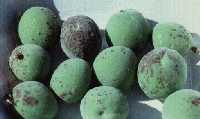by H. Larsen 1 (9/09)* (3/13)
Quick Facts…
 |
| Figure 1: Coryneum blight on green, immature apricots. |
 |
| Figure 2: Coryneum blight on cherry leaves. |
 |
| Figure 3: Ripe peaches infected by coryneum blight just before harvest, showing the sunken rot lesions that developed during two to three weeks of refrigerated storage. |
- Coryneum blight affects peaches, apricots and sweet cherries in Colorado.
- Economic loss results when fruits are blemished and disfigured by spots and lesions from Coryneum blight.
- Outbreaks of this disease take place in spring and early summer and in cool, wet periods prior to harvest.
- Blight is difficult to eradicate because the fungus in infected buds and twigs may produce spores for two to three years.
- Control requires chemical sprays and removal of dead wood over a three-year period.
Coryneum blight — also called shot hole disease, California blight, peach blight or pustular spot — is caused by the fungus Coryneum carpophilum. In Colorado it affects mainly peaches and apricots, and to a lesser degree sweet cherries.
Severe foliar shot holing may weaken a tree, while the most apparent damage is infection of the fruit.
Disease Development
The fungus apparently overwinters in dormant infected leaf buds, blossom buds and small twig cankers. Spore production begins in early spring. The first symptoms of infection are observed on young leaves as small red spots that enlarge and become purple with a white center. These spots then drop out of the leaf blade leaving a “shot hole.” Numerous holes give a very tattered appearance to infected leaves.
Economic loss from Coryneum blight results when peach or apricot fruit are affected. The spots or lesions on the epidermis blemish or disfigure the fruit. Spots may appear on the fruit anywhere from 10 to 12 weeks prior to harvest through the post-harvest period.
Early season infections are characterized by the presence of a reddish-purple halo surrounding a light tan, scab-like center spot, which is the dead fruit skin killed by the fungus. These are similar to damage caused by San Jose Scale, and great care is required to avoid confusion. Depending on weather factors, the spots may remain tiny or enlarge to 1/4 inch in diameter. In severe cases, lesions coalesce and cause skin cracking. Severe, early season infections also can have gummy ooze on the fruit surface.
Late season infections (up to four weeks before harvest) are different and lack the scab-like center and pronounced reddish-purple halo. Infections on the maturing fruit produce sunken, brownish spots up to 1/2 inch in diameter in a fairly short time. These render the fruit unsalable.
Coryneum blight is serious in years when frequent light showers occur during the summer. Wind currents disperse the spores of this fungus from infected twigs and leaves to uninfected branches. These spores require four hours of contact with free water droplets on the fruit, leaf or twig surface in order to germinate and cause infection.
The blight may spread rapidly within an individual tree, with movement from tree to tree somewhat slower. Leaf infections are a constant threat to fruit infection, since leaf lesions produce spores that can infect the fruit whenever weather conditions are favorable.
Temperatures of 70 F to 80 F are optimum for Coryneum infections. Lesions can develop at 45 F but at a much slower rate. It takes from two to five days for a spore to initiate infection and cause a visible lesion.
Control
Once established in an orchard, Coryneum blight is difficult to eradicate. Bud and twig lesions may continue to produce spores for two to three years, but the fungus does not overwinter in old infected leaves.
A conscientious program of chemical control and removal of dead wood is necessary to eradicate the disease.
Under Colorado conditions, most fruit and leaf infections appear to take place in spring and early summer, although cool, wet periods prior to harvest can trigger blight outbreaks at that time.
The best preventive approach is application of chlorothalonil products (like Bravo) or copper-containing products (like Bordeaux mixture, Kocide or Fixed Copper) in the fall when the leaves are easily knocked off the shoots. This protects twigs and buds from infection during wet fall weather and reduces disease carry-over to the next season.
Where disease incidence is or has been high, fungicides may be needed throughout the growing season. Applications should begin between the petal fall and shuck fall stages. Chlorothalonil products give best protection but cannot be applied to fruit after shuck fall. Copper products such as Kocide or Fixed Copper cannot be applied after leaves have emerged because of risk of plant injury. Captan can be applied just ahead of cool, wet weather periods from bloom to just before harvest. Protection by Captan lasts only five to seven days, and Captan has a four-day restricted entry requirement.
Where disease pressure has been high, protection against late season infections on ripening fruit is particularly important during the four or five weeks before harvest.
1Colorado State University Extension fruit pathologist and associate professor; horticulture and landscape architecture, Orchard Mesa Research Center, Grand Junction. 9/99. Reviewed 9/09.
Go to top of this page.





